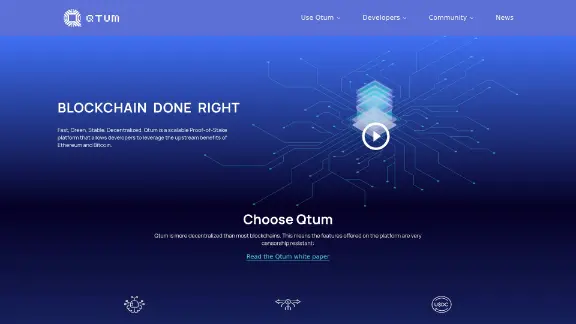Qtum (QTUM)
Qtum is a cryptocurrency designed for enterprise and business applications. In October 2017, it was ranked as the 15th largest cryptocurrency by Coin Market Cap.
Features

| Ticker | QTUM |
| Category | Smart Contract Platform |
| Website | https://qtum.org/en/ |
| @qtum | |
| https://www.reddit.com/r/Qtum |
Qtum combines a modified Bitcoin Core infrastructure with an intercompatible version of the Ethereum Virtual Machine (EVM). This fusion offers the reliability of Bitcoin's blockchain with the versatility of smart contracts. With a focus on stability, modularity, and interoperability, Qtum provides a comprehensive toolkit for developing decentralized applications suitable for real-world business use cases. Its hybrid nature, supported by a unique Point of Sales consensus protocol, ensures compatibility with major blockchain ecosystems and supports mobile devices and IoT appliances. Qtum collaborates with academic partners to standardize business smart contract development, facilitating the translation of human-readable agreements into machine-executable smart contracts.
Technical characteristics
Account Abstraction Layer (AAL)
Qtum's Account Abstraction Layer (AAL) enables seamless interoperability between the UTXO model and the smart contract account model, separating value transfer from contract execution. This layer includes four new opcodes: OP_CREATE for creating smart contracts, OP_CALL for invoking contracts and transferring QTUM, OP_SPEND for allocating QTUM within contracts, and OP_SENDER for allowing another address to cover gas fees. The AAL supports virtual machines like Qtum's x86 VM and the Ethereum Virtual Machine (EVM).
x86 Virtual Machine (VM)
The x86 VM uses the Von Neumann architecture to enable compatibility with popular compilers and programming languages, such as Rust. This approach overcomes limitations found in Ethereum's Solidity and EVM, enhancing features like variable-length keys and on-chain data analysis. Developers benefit from standard libraries, reduced development costs, and improved scalability through storage and lease models.
Mutualized Proof-of-Stake (MPoS)
Qtum utilizes MPoS, an enhancement of PoS 3.0, to incentivize decentralized staking. Block rewards are distributed among the current block producer and nine previous producers, with a portion of the reward deferred, increasing the cost of potential attacks and enhancing network stability.
Decentralized Governance Protocol (DGP)
Qtum’s DGP facilitates governance and blockchain upgrades without contentious hard forks. Through a voting process, stakeholders such as miners, developers, and token holders can self-manage and iteratively improve blockchain parameters.
Qtum 2.0 Enhancements
Qtum 2.0 introduces several upgrades, including Confidential Assets for private asset issuance, Offline Staking for delegating staking to online nodes, and Chain-Cloud Integration to enhance blockchain scalability for commercial applications. These innovations aim to improve Qtum’s functionality, scalability, and developer accessibility.
Standardization
Qtum collaborates with various partners to establish a smart contract hub, offering secure and tested contract templates for industries like supply chain management, telecommunications, IoT, and social networking. The platform also supports QR code usage for easy payments and transfers.
Roadmap
2016
- March 1: The Qtum blockchain project was officially initiated.
- October 31: Completion of the Qtum chain prototype.
- November: Establishment of the Qtum Foundation.
2017
- June 28: Release of Sparknet, Qtum's first testnet.
- August 18: Launch of Skynet, Qtum's second testnet.
- September 13: Deployment of the Qtum mainnet.
2018
- May: Introduction of the Qtum chain x86 virtual machine prototype.
- November: Plasma MVP released to enhance scalability.
- December: Integration of IPFS for decentralized data storage on the Qtum blockchain.
2019
- January 16: Realization of QTUM-BTC atomic exchange using a Decred-based payment script.
- July 2: Public beta release of Qtum Eclair, enabling Lightning Network functionality.
- July 10: QTUM-BEAM atomic exchange implementation announced by the Qtum Foundation.
- October 17: Upgrade of Qtum’s mainnet to version 2.0, featuring its first hard fork.
Tokenomics
Qtum Token ($QTUM)
The initial supply of QTUM, the native cryptocurrency of the Qtum blockchain, was set at 100 million tokens. These tokens were created through coinbase transactions at a rate of 20,000 QTUM per block for the first 5,000 blocks. Of the total supply, 51 million QTUM tokens were distributed through a public token sale in March 2017. The proceeds from this sale support the operations of the Qtum Chain Foundation, including system development, marketing, and consultancy services.
